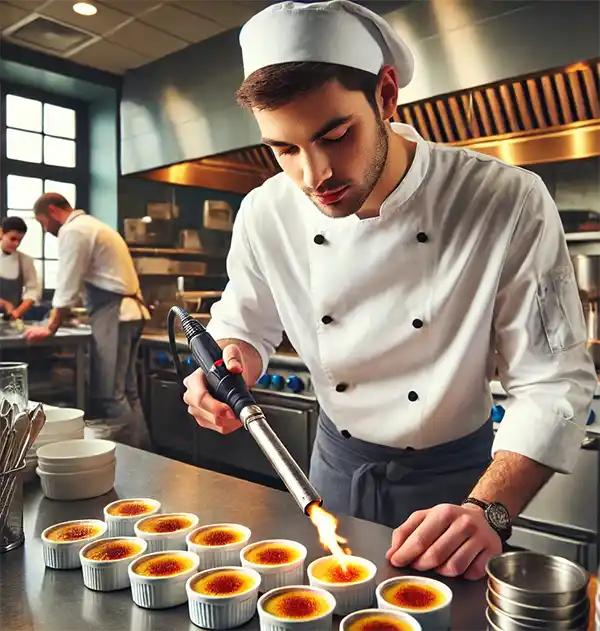A Celebration of Crunchy, Creamy Delight
Ah, Crème Brûlée—the decadent dessert that brings together the best of both worlds: a smooth, velvety custard topped with a crisp, caramelized sugar crust. This luxurious treat is so adored that it has its very own holiday: National Crème Brûlée Day, celebrated on July 27th. It’s a day to indulge in this rich dessert, perfect for those who believe life is too short to skip dessert!
A Culinary Mystery
The history of Crème Brûlée is as rich and complex as the dessert itself. The name is French, translating to "burnt cream," which is a fitting description of the dish. However, the origins of Crème Brûlée are somewhat murky, with several countries vying for the title of its creator.
France, naturally, claims it as its own, with the earliest known reference appearing in François Massialot's 1691 cookbook "Cuisinier Royal et Bourgeois." However, the Spanish have their own version, known as crema catalana, which dates back even earlier to the 14th century. To add more flavor to the debate, the English also have a contender in the form of Trinity cream, which was served at Trinity College, Cambridge, in the 19th century.
Regardless of its true origins, Crème Brûlée has become a staple in fine dining restaurants around the world. Its elegance and simplicity make it a favorite among dessert lovers and chefs alike.
The Anatomy of Crème Brûlée
Crème Brûlée is a delightful study in contrasts. The base is a smooth, creamy custard, typically made with heavy cream, egg yolks, sugar, and vanilla. The real magic happens on top: a layer of sugar is sprinkled over the custard and then caramelized with a torch or under a broiler until it forms a hard, glassy crust.
 The first bite of Crème Brûlée is a sensory experience. The spoon taps against the hard sugar shell, cracking it open to reveal the silky custard beneath. It’s a delightful combination of textures—crunchy, creamy, and utterly satisfying.
The first bite of Crème Brûlée is a sensory experience. The spoon taps against the hard sugar shell, cracking it open to reveal the silky custard beneath. It’s a delightful combination of textures—crunchy, creamy, and utterly satisfying.
The Science Behind the Sweetness
Ever wondered why Crème Brûlée is so irresistibly smooth and rich? The secret lies in the careful cooking of the custard. The mixture of heavy cream, egg yolks, and sugar must be heated gently, usually in a water bath, to avoid curdling. The result is a custard that's perfectly set, yet luxuriously creamy.
And what about that golden, glassy top? When sugar is exposed to high heat, it undergoes a chemical process known as caramelization. This not only gives the sugar its characteristic crunch and deep flavor but also creates the beautiful, glass-like finish that makes Crème Brûlée so visually appealing.
Fun and Fascinating Facts About Crème Brûlée
-
Torching Tradition: The iconic caramelized top of Crème Brûlée is traditionally achieved using a culinary blowtorch. This tool not only gives the dessert its signature crunch but also adds a touch of theatrical flair to its preparation. Nothing says “fancy” quite like wielding a blowtorch in the kitchen.
-
Flavor Variations: While vanilla is the classic flavor, chefs have experimented with a myriad of variations. From chocolate and coffee to lavender and lemon, Crème Brûlée can be adapted to suit any palate.
-
Calorie Count: Despite its rich ingredients, a serving of Crème Brûlée is relatively modest in calories compared to other indulgent desserts. But who’s counting calories on National Crème Brûlée Day anyway?
-
Instant Crème Brûlée?: Believe it or not, there are instant versions of Crème Brûlée available in stores. While they might not hold a candle to the homemade or restaurant versions, they’re a quick fix for a sugar craving.
-
Historical Controversies: The French, Spanish, and English each claim to have invented Crème Brûlée, leading to many a heated debate among culinary historians. It's a delicious mystery that only adds to the dessert's allure.
Crème Brûlée has also made its mark in popular culture. In the movie "Amélie," the titular character delights in cracking the caramelized top of her Crème Brûlée with a spoon—a scene that has become iconic. It’s a testament to the universal appeal of this dessert and its ability to evoke joy with just one tap of a spoon.
Celebrating National Crème Brûlée Day
On National Crème Brûlée Day, the most obvious way to celebrate is by indulging in a serving (or two) of this delectable dessert. Here are a few ways to elevate your celebration:
-
DIY Crème Brûlée: If you’re feeling adventurous, try making Crème Brûlée at home. It’s surprisingly simple, and you get the added bonus of playing with a blowtorch. Just make sure to keep a fire extinguisher handy—safety first, dessert second!
-
Crème Brûlée Tasting: Visit a few local restaurants and sample their versions of Crème Brûlée. Each chef puts their own spin on the classic recipe, so you’re sure to encounter a variety of flavors and presentations.
-
Crème Brûlée Party: Host a Crème Brûlée party and invite friends to bring their own unique versions of the dessert. It’s a fun way to share recipes and enjoy a decadent treat with loved ones.
-
Crème Brûlée Around the World: Take a culinary tour from your kitchen by trying different international variations. Make the traditional French version, the Spanish crema catalana, and the English Trinity cream to appreciate the global appeal of this beloved dessert.
A Humorous Ode to Crème Brûlée
Crème Brûlée, oh Crème Brûlée, Your caramel crust makes my day.
With custard so smooth and sugar so crisp, You’re the dessert I can’t resist.
Torch in hand, I caramelize, Creating a treat that’s a feast for the eyes.
A spoonful of bliss, a moment so sweet, Crème Brûlée, you’re my favorite treat!
The Ultimate Crème Brûlée Recipe
If you’re ready to try your hand at making Crème Brûlée, here’s a foolproof recipe to get you started:
Ingredients:
- 2 cups heavy cream
- 1 vanilla bean (or 1 tsp vanilla extract)
- 5 large egg yolks
- 1/2 cup granulated sugar, plus extra for topping
Instructions:
- Preheat your oven to 325°F (160°C).
- In a saucepan, heat the heavy cream and vanilla bean (split and scraped) over medium heat until it just begins to simmer. Remove from heat and let it sit for a few minutes to infuse the flavors.
- In a bowl, whisk together the egg yolks and sugar until the mixture is pale and thick.
- Slowly pour the warm cream into the egg mixture, whisking constantly to avoid cooking the eggs.
- Strain the mixture through a fine sieve to remove any lumps or vanilla bean pieces.
- Pour the custard into ramekins and place them in a baking dish. Fill the dish with hot water until it reaches halfway up the sides of the ramekins.
- Bake for 40-45 minutes, or until the custards are set but still slightly jiggly in the center.
- Remove the ramekins from the water bath and let them cool to room temperature, then refrigerate for at least 2 hours.
- Before serving, sprinkle a thin layer of sugar over each custard and caramelize it with a blowtorch until golden and crisp.
- Enjoy your homemade Crème Brûlée!
So, whether you’re a seasoned pastry chef or a dessert enthusiast, take a moment on July 27th to appreciate the creamy, crunchy perfection of Crème Brûlée. It’s a celebration of indulgence, elegance, and the simple joy of a well-made dessert. Happy National Crème Brûlée Day!
Please Share our Content






 The first bite of Crème Brûlée is a sensory experience. The spoon taps against the hard sugar shell, cracking it open to reveal the silky custard beneath. It’s a delightful combination of textures—crunchy, creamy, and utterly satisfying.
The first bite of Crème Brûlée is a sensory experience. The spoon taps against the hard sugar shell, cracking it open to reveal the silky custard beneath. It’s a delightful combination of textures—crunchy, creamy, and utterly satisfying.








 "Sláinte!" is a traditional Irish expression used as a toast, equivalent to "Cheers!" in English.
"Sláinte!" is a traditional Irish expression used as a toast, equivalent to "Cheers!" in English.